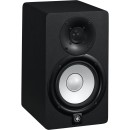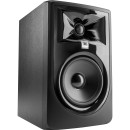JBL 305P MkII vs Yamaha HS5: Which Studio Monitor is Right for You?
The JBL 305P MkII Studio Monitor Speaker and the Yamaha HS5 Studio Monitor Speaker are both highly regarded in the world of audio production, yet they cater to slightly different needs and preferences. The JBL 305P MkII features a 5-inch woofer and a 1-inch tweeter, offering a frequency response from 49Hz to 20kHz. It is equipped with JBL's innovative Image Control Waveguide, which provides a broad sweet spot and detailed imaging. With a power output of 82 watts, the JBL 305P MkII is well-suited for small to medium-sized studios. Its sleek design and front-firing port make it adaptable to various room placements, and it includes boundary EQ settings for optimizing bass response in different environments.
On the other hand, the Yamaha HS5 Studio Monitor Speaker is known for its exceptional accuracy and flat frequency response, which extends from 54Hz to 30kHz. It features a 5-inch cone woofer and a 1-inch dome tweeter, powered by a bi-amp design that delivers a total of 70 watts. The HS5 is part of Yamaha's renowned HS series, which is celebrated for its natural sound reproduction. Its rear-firing port and room control settings allow users to adjust the low-end response, making it ideal for precise audio work in well-treated rooms. The HS5's minimalistic design is both elegant and functional, fitting seamlessly into professional studio environments.
When comparing the two, the JBL 305P MkII is known for its wider soundstage and versatile placement options, making it a favorite among those who require flexibility in their studio setup. The Yamaha HS5, however, is often chosen by professionals who prioritize a neutral sound signature and detailed audio analysis. Both monitors offer excellent build quality and performance, but the choice between them depends largely on personal preference and specific studio requirements. Each speaker excels in delivering clear, accurate sound, catering to different aspects of the audio production process.
In the following sections, we will delve into a detailed comparison of the JBL 305P MkII and Yamaha HS5 studio monitor speakers. We'll thoroughly examine their specifications, as well as review their advantages and disadvantages. This comprehensive analysis is designed to help you understand the key differences and choose the right studio monitor for your needs.
Detailed Specifications and Features Comparison
| User Rating Based on Analysis of Reviews | |
|---|---|
|
Show More |
| Pros: | |
|---|---|
|
|
| Cons: | |
|---|---|
|
|
| Find Best Price | Find Best Price |
| Key Specs | |
|---|---|
| Monitor Type & Configuration | |
| Active 2-Way | Active 2-Way |
| Total Power Output | |
| 70 W | 82 W |
| Tweeter | |
| 1x 1" / 25.4 mm Dome | 1x 1" / 25.4 mm Dome |
| Woofer | |
| 1x 5" / 12.7 cm Cone |
1x 5" / 12.7 cm Cone |
| Frequency Range | |
| 74 Hz to 24 kHz (-3 dB) 54 Hz to 30 kHz (-10 dB) |
43 Hz to 24 kHz (-10 dB) |
| Audio I/O | |
| 1x XLR 3-Pin Balanced Input (10 Kilohms) 1x 1/4" TRS Balanced Input (10 Kilohms) |
1x XLR 3-Pin Balanced Line Input 1x 1/4" TRS Balanced Line Input |
The JBL 305P MkII Studio Monitor Speaker and the Yamaha HS5 Studio Monitor Speaker are both noteworthy options in the realm of active 2-way studio monitors, each tailored for professional audio applications. The JBL 305P MkII boasts a total power output of 82 W, while the Yamaha HS5 offers a slightly lower power output of 70 W. This difference in power may influence the overall loudness and headroom available for mixing and monitoring tasks.Show More
Both speakers feature a 1-inch dome tweeter and a 5-inch cone woofer, ensuring that they can reproduce high frequencies clearly while providing a solid low-end response. However, their frequency ranges differ, with the JBL 305P MkII extending from 43 Hz to 24 kHz (-10 dB), which allows for deeper bass performance compared to the Yamaha HS5, which ranges from 74 Hz to 24 kHz (-3 dB) and 54 Hz to 30 kHz (-10 dB). This makes the JBL a better choice for those who prioritize low-frequency response in their monitoring environment.
In terms of audio inputs, both models are equipped with 1x XLR 3-Pin Balanced Line Input and 1x 1/4" TRS Balanced Line Input. The Yamaha HS5 features a balanced input impedance of 10 Kilohms for both connections, which can be beneficial for compatibility with various audio sources. However, neither speaker offers digital or network I/O options, nor do they support wireless connectivity, which is a common characteristic within this segment of studio monitors.
| General | |
|---|---|
| Number of Included Monitors | |
| Single Monitor | Single Monitor |
| Enclosure | |
| Bass-Reflex/Ported | Bass-Reflex/Ported, Shielded |
| Total Power Output | |
| 70 W | 82 W |
The JBL 305P MkII Studio Monitor Speaker and the Yamaha HS5 Studio Monitor Speaker are both single monitor speakers designed for professional audio applications. The JBL 305P MkII features a total power output of 82 W, while the Yamaha HS5 has a slightly lower total power output of 70 W. This difference in power may affect the overall loudness and headroom of the speakers, with the JBL model likely providing a higher maximum sound pressure level.Show More
In terms of driver specifications, the JBL 305P MkII is equipped with a 1x 1" tweeter and a 1x 5" woofer, whereas the Yamaha HS5 also utilizes a 5" woofer but has a 1" tweeter. Both speakers use a bass-reflex/ported enclosure, which enhances low-frequency response. However, the JBL model boasts a broader frequency range of 43 Hz to 24 kHz compared to the Yamaha HS5's frequency response, which emphasizes clarity in the mid to high frequencies.
When examining the performance characteristics, the JBL 305P MkII achieves a maximum sound pressure level (SPL) of 108 dB and a signal-to-noise ratio of 75 dBA, indicating a potentially more dynamic range and clarity in sound reproduction. The Yamaha HS5 does not specify its SPL or SNR, which may be a consideration for users seeking detailed performance metrics. Additionally, the JBL speaker features a peak limiter and customizable EQ settings (HF and LF Shelf) for tuning the sound, while the Yamaha HS5 lacks these specific protections and adjustments.
Lastly, the JBL 305P MkII utilizes a Linkwitz-Riley crossover type with a crossover frequency of 1725 Hz, which can contribute to a more coherent soundstage. In contrast, the Yamaha HS5 does not specify its crossover design, which may influence the phase response and overall tonal balance. Both speakers are designed to meet professional audio standards, but the JBL 305P MkII's specifications may provide an edge in terms of power, range, and versatility.
| Connectivity | |
|---|---|
| Audio I/O | |
| 1x XLR 3-Pin Balanced Input (10 Kilohms) 1x 1/4" TRS Balanced Input (10 Kilohms) |
1x XLR 3-Pin Balanced Line Input 1x 1/4" TRS Balanced Line Input |
| Network I/O | |
| USB | |
| Wireless | |
The JBL 305P MkII Studio Monitor Speaker features an audio input configuration that includes 1x XLR 3-Pin Balanced Line Input and 1x 1/4" TRS Balanced Line Input. This provides versatility for connecting various audio sources, ensuring high-quality sound reproduction. However, it does not support digital audio I/O, network I/O, USB, or wireless connectivity, nor is it compatible with any mobile applications, limiting its integration with modern digital setups.Show More
On the other hand, the Yamaha HS5 Studio Monitor Speaker also offers a similar audio input configuration with 1x XLR 3-Pin Balanced Input (10 Kilohms) and 1x 1/4" TRS Balanced Input (10 Kilohms). While it shares the same lack of digital audio I/O, USB, wireless capabilities, and network I/O, it is noted for its high input impedance, which can be beneficial for certain audio applications.
In summary, both the JBL 305P MkII and Yamaha HS5 studio monitors are equipped with similar audio input options, offering balanced connections essential for professional audio work. However, neither speaker provides modern connectivity features such as digital or wireless options, which may limit their functionality in more advanced setups. Ultimately, the choice between these two may come down to brand preference and specific audio needs rather than significant differences in connectivity features.
| Power | |
|---|---|
| AC Input Power | |
| Not Specified by Manufacturer | 100 to 240 VAC, 50/60 Hz |
The JBL 305P MkII Studio Monitor Speaker boasts an AC input power range of 100 to 240 VAC at a frequency of 50/60 Hz, making it versatile for various international power standards. This feature enhances its usability across different locations, ensuring that users can easily plug it in without compatibility issues. In contrast, the Yamaha HS5 Studio Monitor Speaker does not specify its AC input power, which might raise questions about its adaptability in certain environments.Show More
When it comes to power consumption, the Yamaha HS5 is rated at 45 W, indicating its energy usage during operation. This can be a significant factor for users conscious of energy efficiency. The JBL 305P MkII does not specify its power consumption, leaving potential buyers without a clear understanding of its energy requirements.
Both speakers feature a black color, ensuring they will fit well in most studio environments. The Yamaha HS5 is constructed with an enclosure made of MDF, providing durability and acoustic properties suitable for studio monitoring. The JBL 305P MkII's enclosure material is not specified, which could be a consideration for users focused on build quality. Additionally, the Yamaha HS5 lacks mounting points, which may limit its placement options in a studio setup, while the JBL 305P MkII's mounting capabilities are also not detailed.
In terms of dimensions, the Yamaha HS5 measures 6.7 x 11.2 x 8.7 inches (17 x 28.5 x 22.2 cm), making it relatively compact and easy to integrate into smaller spaces. It weighs 11.7 lb (5.3 kg), contributing to its portability. The dimensions and weight of the JBL 305P MkII are not provided, which could affect decisions for users with specific space constraints or weight considerations in their studio.
| Packaging Info | |
|---|---|
| Package Weight | |
| 16.2 lb | 12.55 lb |
| Box Dimensions (LxWxH) | |
| 16.4 x 12 x 10.2" | 14.8 x 10.2 x 2.5" |
The JBL 305P MkII Studio Monitor Speaker weighs 12.55 lb and has compact dimensions of 14.8 x 10.2 x 2.5 inches. This lightweight design makes it an ideal option for those with limited studio space or for mobile setups, allowing for easy transport and placement in various environments.Show More
In contrast, the Yamaha HS5 Studio Monitor Speaker has a heftier package weight of 16.2 lb and larger box dimensions of 16.4 x 12 x 10.2 inches. While this additional weight may suggest a more robust build, it also means less portability compared to the JBL model. The HS5 might require more dedicated space within a studio setup.
Overall, the choice between these two monitors may come down to the user's specific needs regarding weight and size. The JBL 305P MkII offers a lighter and more compact solution, while the Yamaha HS5 provides a more substantial presence but at the expense of portability.
| Customer Images | |
|---|---|
| Videos | |
|---|---|
|
|
|




















